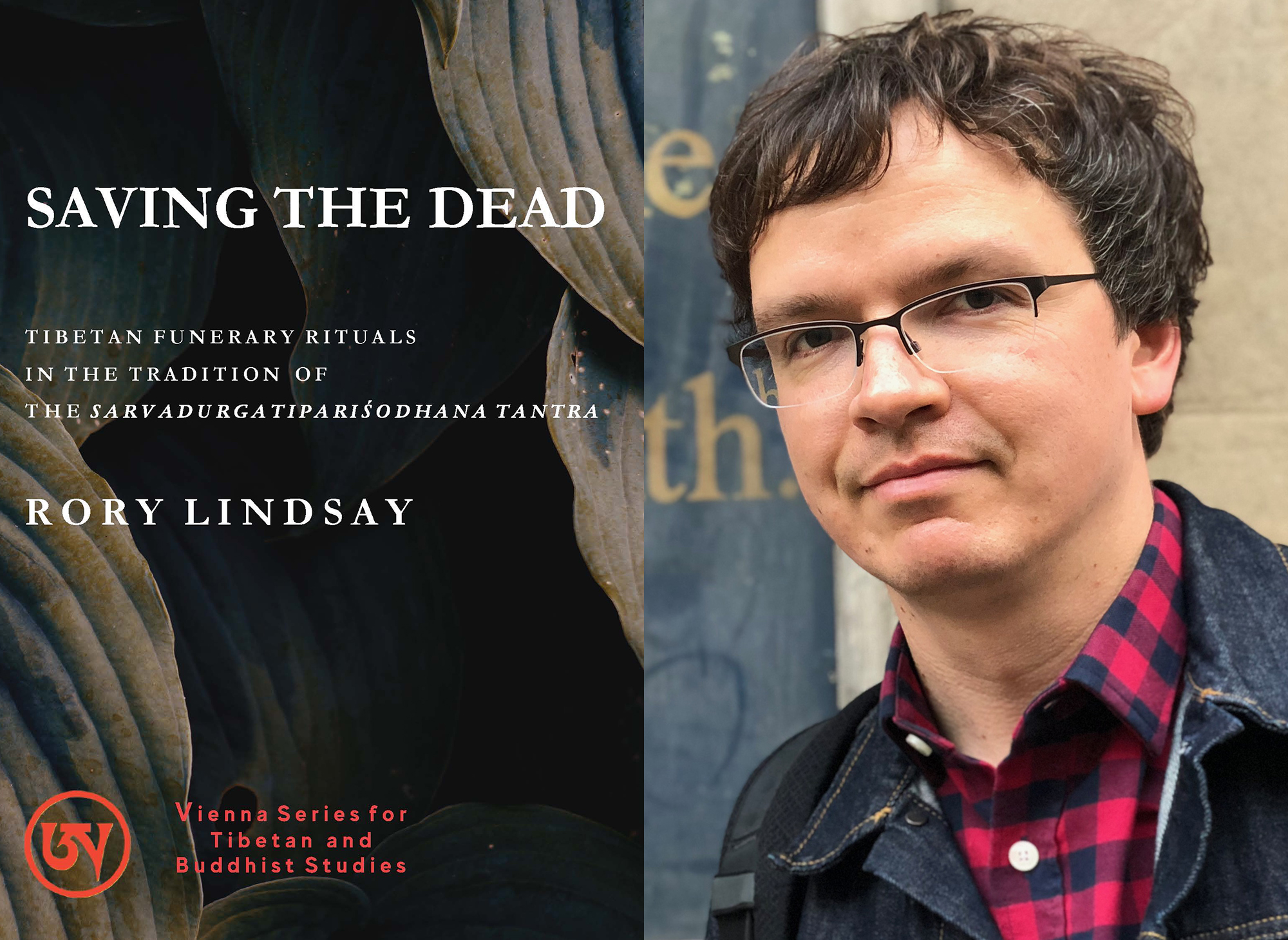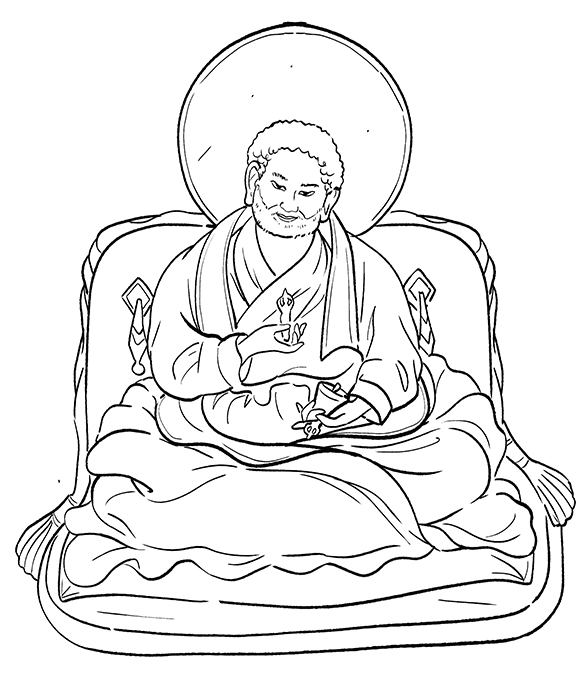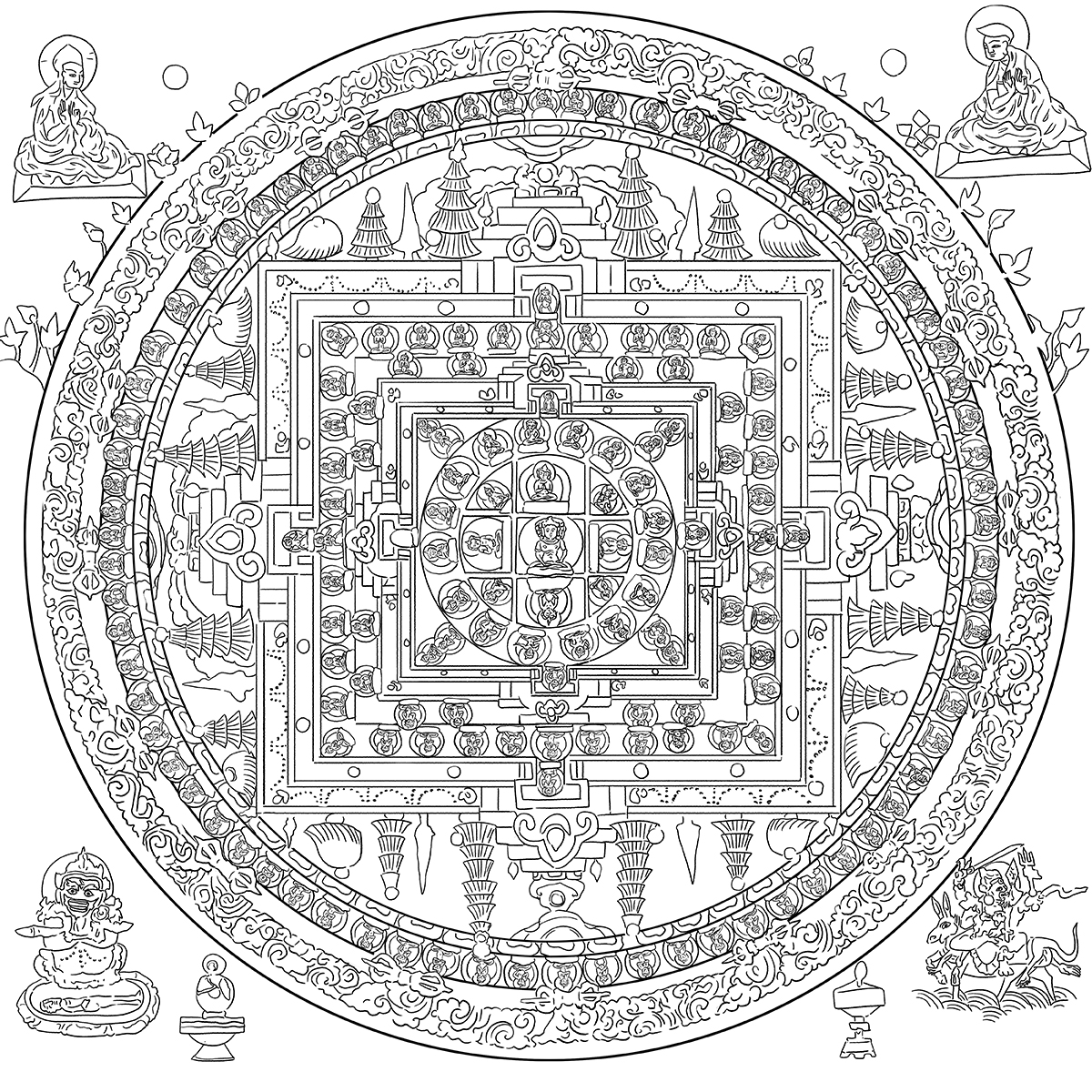← Back to Spring 2024 Newsletter Contents

Rory Lindsay is an assistant professor in the Department for the Study of Religion, an editor at 84000: Translating the Words of the Buddha, and a visiting scholar at the Buddhist Texts Translation Initiative at the University of California, Santa Barbara.
Lindsay’s first book, Saving the Dead: Tibetan Funerary Rituals in the Tradition of the Sarvadurgatipariśodhana Tantra (Vienna Series for Tibetan and Buddhist Studies, 2024), explores Tibetan funerary manuals. Focusing on the writings of the 12th-century scholar Jetsün Drakpa Gyaltsen and his discussions of agency—human, non-human, and material—the book also explores points of contention including methodologies for site preparation in funeral rites, visualization practices involving objects representing the deceased, and the relationship between tantric (doctrinal) narrative and ritual enactment.
In this Q&A we ask Rory Lindsay about the book and the complex interactions that characterize this area of study.
In your book's introduction, you discuss the Sarvadurgatipariśodhana Tantra (SDP), in which the dead are passive recipients of liberating rites. This is unlike other Indian and Tibetan Buddhist frameworks where the dead can actively achieve self-liberation through engaging in yogic practices in the intermediate state between lifetimes. You raise questions about who performs the work of saving the dead—ritual experts, deities, material objects, or the ritual manual itself. Could you comment on the social dimensions of these funerary practices?
My first exposure to Tibetan funerary practices was through popular English-language works like The Tibetan Book of the Dead, which describe the bardo, or intermediate state between death and rebirth, as a critical opportunity for the deceased to break free from cyclic existence. When I began translating early Tibetan funerary manuals based on the SDP, one of the most striking features of these works was that the dead didn’t seem to do anything at all. Questions of post-mortem agency became important as I explored the soteriological [doctrine of salvation] claims these ritual manuals were making. I wondered how the authors of these texts might justify the idea that a person’s karma could be purified through rituals performed by others, and I realized that these texts were describing a complex ritual world in which a vast network of social actors including more-than-human beings and material objects could work together in highly formalized and specific ways to assist the dead.
Light Rays for the Benefit of Others: The Rituals of Sarvavid is a commentary on the SDP by the Tibetan author Jetsün Drakpa Gyalten, which has played a significant role in the development of funerary rites in Tibet. What has been his influence?
Drakpa Gyaltsen (1147–1216) was one of the founders of the Sakya school of Tibetan Buddhism, and his writings on SDP-oriented funerary practices were arguably the most influential in Tibetan history. Almost every Tibetan author who wrote about this topic had to answer to his works in some way, even writers belonging to other lineages.

(illustration: Doan Trang)
Does the desire for a set of rituals to follow make it hard for them to change over time?
The question of changes to these practices is interesting in that certain writers claimed to be writing in accordance with the “intent” of Drakpa Gyaltsen, yet they still produced their own manuals that differed from Drakpa Gyaltsen’s in significant ways. So officially these new works were supposed to be conservative but actually were often quite innovative.
Light Rays gives detailed instructions on what one should do when performing an SDP-based funeral, yet the text might also instruct officiants to follow what they have seen others do. How might that work in practice?
In most Tibetan ritual performances, the officiants will rely on ritual manuals. These texts direct the reader through each stage of the ritual undertaking, though they also give the reader choice. My sources sometimes instruct the reader to rely on “visual transmission,” a term I hadn’t seen used in other contexts, which refers to empirical learning. It was fascinating to see this foregrounded given that in contemporary scholarship empiricism has sometimes been framed as being at odds with tantric ways of knowing, but here it is explicitly acknowledged as being essential to successfully performing these practices.
A paradoxical element you raise concerns prescriptive manuals that are used in ritual contexts. The manuals you are reading become elements in the very practices they prescribe. Could you elaborate on that a little?
In my analysis I tried to foreground how the ritual manuals themselves—the very texts I was working with—in performative contexts serve as agents. They extend the agency of their authors into the ritual environment and intervene in the ritual present. They also use verb forms that express what the reader should do in an ideal ritual performance but leave room for scenarios where this ideal can’t be achieved.
Karma is regarded as intentional acts of body, speech, and mind but there can be a disconnect between a person’s intentions and what follows. What is the significance of that?
Buddhist traditions would typically argue that unintentional acts do not generate positive or negative karma. These traditions would also contend that any given event is the result of a complex network of causes and conditions. The ritual processes that I discuss in my book reflect this expansive thinking beyond simple cause-and-effect relationships to engage a vast network of actors who are believed to be capable of working through the complexities of karmic accumulations and reverse their negative effects.
What function does the ritualists’ intercession serve?
Ritual performers are expected to engage in advanced meditative practices at the outset of the funerary rites that allow them to merge their identities with Buddhist deities. Indian and Tibetan Buddhist traditions argue that without this, the liberating power of the rituals would not be possible. Tibetan scholars who debated the finer points of these rites say explicitly that it is the ritualists and the deities who serve as primary agents in saving the dead. There is no supreme creator god who judges the individuals who are in need. Rather, it is buddhas who help the dead find rebirth in a better circumstance in which they can achieve higher states of realization and eventually break free from cyclic existence altogether.

(illustration: Doan Trang)
You say that “the rituals involve purifying the karma of the deceased through processes of … empowerment and cremation, which are said to free the dead from bad rebirths.” What is empowerment in this context?
For the living, empowerment involves being introduced to the practices of a particular deity and entering into their maṇḍala [their palace, in which they are accompanied by their retinue]. In the case of these funerary practices, the ritualists will bestow posthumous empowerment on the deceased in order to forge that same connection on their behalf. This is said to be powerful enough to propel the deceased to a pure land where they can engage in Buddhist practice without interruption or interference.
It is claimed that following the SDP’s rituals can save those who have “committed terrible acts over many lifetimes.” This is very different from some other traditions, where one is responsible for one’s own salvation. (Is there the possibility, too, of the wealthy being able to fund a concerted, “proper” set of rituals to offset bad behaviour during life?)
The SDP sets limits on who can be rescued by its rituals, noting that some individuals who have committed particularly bad actions and who have no connection to Buddhist tradition need to experience the results of their negative karma before they can make progress on the Buddhist path. This goes some distance in protecting against what you’re describing, but you’re right that these rituals are elaborate and expensive to sponsor, meaning that the wealthy would more easily be able to arrange them. That said, sometimes these rituals are performed in public settings where anyone in attendance can submit the names of those who have died in order to benefit them, in which case costs are kept to a minimum. It would just depend on the context in which the rites were being performed.
Thank you for this interesting overview of your work. Is your next project related to this topic?
My next book will be totally different! It builds on a project I started years ago while I was an MA student in the DSR. I’m working with a Tibetan scholar, Khenpo Tashi Dorje, to write about his great uncle, Drayab Lodrö Gyaltsen, who was an important Buddhist teacher in eastern Tibet. Drayab Lodrö had a very dramatic life and was twice imprisoned, so we’re working to tell his story and translate his most important philosophical text. I am also co-editing two volumes: one is a festschrift for one of my mentors, Professor José Cabezón, which I’m editing with Professor Vesna Wallace, and the other is an edited volume of essays on the Tibetan Buddhist canon, which I’m working on with Dr. Adam Krug.


